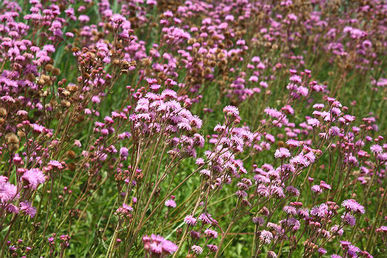
This plant is a Category ONE Invasive plant. What that means to you is: " These are plants that must be controlled on land or water surfaces by ALL land users."
This category includes Lantana, Bugweed, Pampas Grass, Cat's Claw creeper, Oleander, and Balloon Vine.
Please note that if you are found guilty of neglecting to attend to these plants a fine of 4 years jail term or R10 000 or BOTH applies.
What to do, when and how
The Pompom spreads by rhizome and by seed. Cutting the plant down, or burning is NOT effective. The experience in the RNC is that this practice encourages vigourous growth, and rapid spread through the rhizome. THe rhizome (root system) is well protected under the soil, not affected by burning, and leaves the Pompom ready to grow.
The Pompom thrives in disturbed or degraded soil. Pay close attention to these areas.
In the RNC action has in the past often been taken too late. This may be because the flowring season begins when we all want to go on holiday, and wind down for the year. This is when the pompom "gets busy"!
When the pompom is already flowering, many owners have included de-heading in their treatment regime. The flowers are cut off, bagged and burnt. This activity adds greatly to the duration and cost of the treatment intervention. Also, walking through the flowering plants, some already seeding, disperses the seeds quickly and widely.
If you are able to apply herbicide while the plant is growing, i.e. before the flowering commences, the intervention will be more effective.
Try to use "spot application" rather than dispersed spraying. Spray only the pompom plant, focusing on the leaves.
After 3-5 days the plant will appear to be wilting. Leave in place and undisturbed as the plant will die over 10-14 days.



 RSS Feed
RSS Feed

